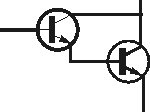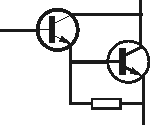The Darlington Pair is a useful circuit configuration for many applications within electronic circuits. The Darlington transistor configuration provides a number of advantages that other forms of transistor circuit are not able to offer and as a result it is used in many areas of electronics design. The Darlington Pair also occasionally referred to as a super-alpha pair is renowned as a method for obtaining a very high level of current gain, using just two transistors. It is able to provide levels of gain that are not possible using single transistors on their own, but it may not be used in all circumstances because it does have a number of limitations.
The Darlington Pair may be used in the form of discrete components, but there are also very many integrated circuit versions often termed a Darlington transistor that may also be used. These Darlington transistor components may be obtained in a variety of forms including those for high power applications where current levels of many amps may be required.
The Darlington Pair has been in use for very many years. It was invented in 1953 by Sidney Darlington who was working at Bell Laboratories. He developed the idea of having two or three transistors in a single semiconductor chip, where the emitter of one transistor was connected directly to the base of the next, and all the transistors shared the same collector connection. In many ways the Darlington bore many of the hallmarks of the first integrated circuit patent, but it was too specific to the specific Darlington circuit itself to be considered as an integrated circuit.
Darlington pair basics
When using an emitter follower in a circuit, the level of current gain, and the input impedance of the circuit is limited by the current gain that can be achieved using a single transistor. The gain of the Darlington transistor pair is that gain of the two individual transistors multiplied together.
The basic Darlington transistor circuit is formed by taking the emitter of the input transistor and connecting it such that its emitter drives the base of the second and then connecting both collectors together. This circuit can be used as any single transistor would be in a variety of circuits, but particularly as an emitter follower.

In many respects a Darlington pair can be treated like a single transistor with a very high gain, and in these instances it is often shown on a circuit diagram as a single component.

While the Darlington can be viewed almost as a circuit block or component in its own right, it does have several differences between it and the basic transistor. For example it has a higher voltage difference between the overall base and emitter, i.e. from the base of the input transistor to the emitter of the output transistor.
This means that for a typical silicon device, the overall base emitter voltage required to turn the Darlington pair on is two times 0.7 volts, i.e. 1.4 volts.
A further point to note is that the saturation voltage of the Darlington configuration is about 0.7 volts. This is higher than that of a single transistor, where, for example a switching transistor may exhibit a saturation voltage of around 0.2 volts. The increased level of saturation voltage of the Darlington pair needs to be considered in some applications where high currents are passed because it may result in significant levels of power being dissipated in the device.
It is also necessary to be aware that the Darlington Pair is not as fast as a single transistor. This is because the first transistor cannot actively shut off the base current of the second transistor. In turn this makes the overall device or circuit configuration slow to reduce the current flow or switch off. To address this problem, the second transistor often has a resistor connected between the base and emitter. This resistor also helps prevent any leakage current from the input transistor from turning the output transistor on. This leakage current can be of the order of nano-amps for a small signal transistor or up to a few hundred micro-amps for a power transistor. The value of the base emitter resistor is chosen so that it does not sink a large proportion of the current intended to pass through the base of the output transistor, while not allowing the leakage current to develop a voltage equal to the turn on voltage of the output transistor to be developed. Typical values for the resistor may be a few hundred ohms for a power transistor Darlington or a few thousand ohms for a small signal version.

When using a Darlington pair configuration in a new electronics design, it is necessary to account for the fact that it has a greater phase shift at high frequencies than a single transistor. This can result in the overall circuit having a greater likelihood of becoming unstable if negative feedback is used in the circuit.
Often when making a Darlington pair, the output transistor is required to be able to handle high levels of current. High power transistors typically have lower levels of current gain than the small signal varieties. This means that often the input device in the Darlington pair or Darlington transistor is a small signal high gain variety, whereas the output transistor is a high power device with an inherently lower current gain.
Darlington pair advantages and disadvantages summary
While the Darlington pair offers many advantages they also have limitations. Accordingly when considering the use of the Darlington pair, it is necessary to weigh up both sides of the equation.
| ADVANTAGES: | DISTADVANTAGES: |
|---|---|
|
|
Darlington pair applications
Darlington pairs find applications in many areas. Offering a very high level of current gain they can be used to good effect in many areas. However when using the Darlington pair, its limitations must also be considered. As a result, its use is limited to a number of areas where its limitations are not a major problem. Some typical areas where the Darlington is used include:
- Audio power output stages: Sometimes audio amplifier power output stages may require significant levels of current gain to enable them to drive low impedance speakers. The limited bandwidth and is unlikely to affect the frequency response over the frequency ranges being used.
- Linear power regulators: The Darlington circuit configuration is ideal for use in linear power regulators. There is a requirement for the circuit to be able to drive high current levels and in this respect high levels of current gain are required. It is necessary to consider the slow response on the suppression of spikes in the design.
- Photo-Darlington: Phototransistors are widely used in sensors. To improve the sensitivity of these devices, photodarlingtons are available. These offer considerably higher levels of sensitivity and as a result they are widely used.
- General high power applications: The high current gain capability of the Darlington transistor makes it ideal for controlling high current levels. As a result special Darlington transistor modules are available that are able to carry current levels of 100 amps and more. These Darlington transistor modules are often relatively large and employ screw terminals and are designed for mounting on large heat-sinks. Possible end applications for these devices may include inverter circuits, AC motor control, DC motor control circuits and emergency power supplies, etc..
- LED and Display drivers: Darlington transistor arrays contained within IC packages are widely used for driving loads from standard logic families. Here high levels of current gain are required, making the Darlington an ideal choice. Typical arrays are suitable for driving LEDs, displays, solenoids or other loads. Often these arrays have built in suppression diodes to prevent any reverse voltages (back EMFs) from any inductive loads from destroying them when the current is switched off.
These are only a few examples of where the Darlington pair configuration can be used. They can be used in many other areas where high current gain is needed.
Darlington pair summary
The Darlington pair transistor circuit configuration can be very useful in electronics circuit design. Although it has speed limitations, the Darlington Pair is nevertheless very useful in many areas where high levels of current gain are required, particularly for emitter follower style applications.
Although the Darlington pair is most usually referred to by this name, the older name - the super-alpha pair may still be used on some occasions. This name for the Darlington, was more widely used in the 1960s, and its has largely been superseded, although it may persist in some areas.
Freddy R Vallenilla R
16.791.006
CAF
No hay comentarios:
Publicar un comentario